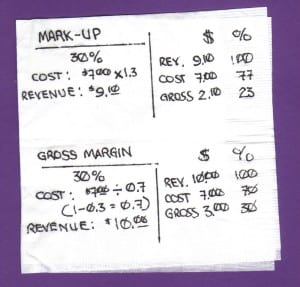Ever wonder how a contractor comes up with a price for a project?
The formula is pretty simple. Â You take the hard costs of the project (labor, materials, subcontractors, permit fees, etc) and apply a markup to come up with the price that you want the client to pay.
 Each business must determine their own markup based on their own costs of doing business.  Contrary to popular belief, there is no such thing as a standard markup.  It would be like Walmart and Nordstrom having the same markup.  Or McDonald’s and Ruth’s Chris Steakhouse.  Or…you get the idea.
Here’s how I determine my markup:
Annual sales – COGS = Gross profit
Gross profit – overhead = Net Profit
Net Profit = 8%
 Ok, if you aren’t a bean counter this may look like mumbo-jumbo, but bear with me.
Annual sales is the revenue you expect to generate- the total of the sale price to all of your clients for the year
COGS (Cost of Goods Sold) is the direct job costs (labor, materials, subs) attributable to specific projects.
Gross Profit is the difference between sales and COGS.  Basically, it’s what you have left to pay your overhead and (hopefully) net profit.
Overhead is expenses you have for being in business not specifically attributable to any one project.  Owner’s salary, business license, insurance, cell phone, computer, software, truck, fuel, marketing, and accountant fees are all examples of overhead.  Overhead should be easy to calculate.
Net Profit is what you have left after you’ve paid all job costs and overhead (including Owner’s salary).  A worthy goal is to make an 8% net profit (think of it like you would any other investment- your rate of return should be adequate for the risks you take, inflation, etc.)  If you missed anything on your bid- it comes from here unless you can legitimately charge it to the client.
 Just like you can’t defy the laws of gravity for long, you can’t defy the laws of economics for long either.  Don’t charge enough and you’ll go broke.  It’s that simple.
Unfortunately, too many contractors have no idea how to calculate their markup.
This is one of the reasons why you often hear of wildly varying estimates for the same project (the ol’ low-ball estimate being another culprit, but we’ll save that for another post).
Why are many contractors clueless when it comes to determining the appropriate markup for their business?  Aren’t they licensed, bonded and insured?  Ha!  In most states, if you can fog a mirror, fill out some forms and pay for the license and bond fee- you’re a contractor!  The barrier to entry is not exactly high.  I’m not advocating more barriers to entry (I’m all about freedom, baby!).  I’m in favor of an educated consumer being able to engage in a mutually beneficial business transaction.  As a consumer, you are responsible to properly prepare yourself to intelligently enter into a contract.  There is no one else who can do that for you.
 So, what’s your markup?
I’ve been asked many times about my markup.  While I don’t usually divulge my markup (I feel that it’s kind of like me asking a client for their W-2’s).  What I can tell you is that I know my costs and I do not have any wasteful overhead whatsoever.  I am pretty efficient.  My staff consists of me, my computer, my smartphone and my iPad.  None of my helpers need breaks, sick leave or workman’s comp insurance!
Some might think this isn’t very transparent on my part.  But consider this.  When I enter into a contract with a client it’s for a fixed price.  By doing this, I am taking full responsibility for the accuracy of the project costs.  I don’t burden my clients with unnecessary change orders.  If I miss something I bear the costs. That’s why I provide very detailed specifications on each job which clearly describes all of the project details.  All fixtures, finishes, means and methods are spelled out.  To me, this is incredibly transparent.
Consider the alternative.  Let’s say you hire a contractor who shows you all of the numbers- line by line- including the markup.  Do you understand what the numbers mean and what they truly will cover?  Do the allowances cover the level of finish you want?  Is each line item padded?  Is the agreement structured in such a way where you take all of the risk while the contractor racks up a tidy sum in change orders?  Are you experienced enough to know if the contract is skewed to the contractor’s benefit?
Ultimately, you have to decide what you’re most comfortable with when embarking on a remodel or custom home project with a General Contractor.  I hope this article has been helpful in shedding some light on the often mysterious subject of contractor markup.  If you have any questions or comments I’d love to hear from you.
Brian Kashas

0 Comments